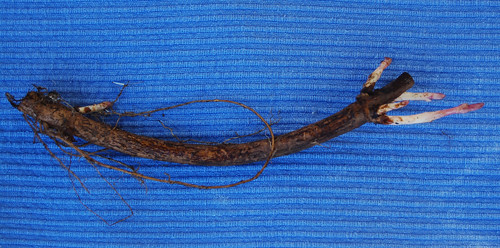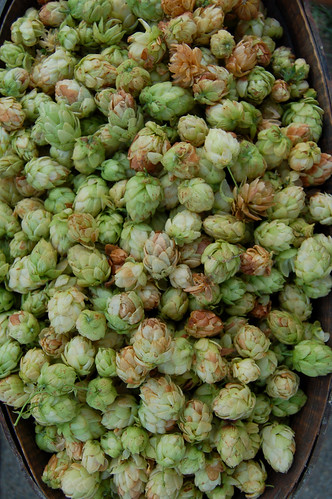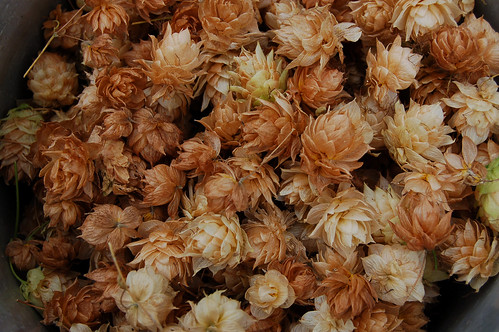Hop To It!
...

For the past two years, we've been growing hops. Our intention is to use our own hops for flavoring home-brewed beer.
We started with twiggy rhizomes, ordered from The Thyme Garden. It really is hard to imagine how huge these unassuming things proto-plants become.
We had read that we would not see much in the way of growth on our first year, but this was a filthy lie.
Last year, the hops almost engulfed our garage. It was comical to see the rate of growth. Robb kept having to add on more structures for the continued growth.
This time around, Robb built an improved system on which to grow the hops, involving good support, and rather shaggy ropes.

The plants grew at markedly different rate, and back in September, we harvested our first hops, from the Sterling plant.
The hop cones were still green, but had dried enough to harvest.
If you read much about hop-growing, or if you lurk around living history museums, you'll come across the much reported "fact" that traditional hop harvesting involved jumping up and down on the dried cones. This, we are told, is the origin of the word describing an informal dance or "hop." I can tell you from experience that there's some merit to this idea. Late season hop plants are just crawling with spiders. And if there's any activity that would inspire jumping up and down, it's the act of repeatedly and blindly shoving one's hand into a spider-riddled thicket. If I hadn't been balancing on a ladder, I would certainly have been doing my version of the spider dance.

Quite typically, I started the hop harvest late in the day, without any real plan for what to do with the cones once I'd gotten them. So I parked them in our laundry room overnight.
The next morning, the bowls containing the hop cones were swarming with aphids. Apparently these aphids had been deep inside the crevices of the cones, but once the cones were disconnected from their juicy stems, the aphids went on the prowl. It was really disgusting. Quite by accident, I discovered that the aphids were attracted to the broken ends of hop leaves. So we covered the bowls with hop leaves, which we used as aphid traps. We kept swapping out leaves until there weren't any more aphids on them.
Turns out that hop aphids overwinter on plum trees. Great. We've got both hops and plums, which means we're creating quite a nursery for these creatures. Since we garden organically, we're not really sure how to deal with the aphids.
Extra protein in the beer, right?
(How many of our blog readers remember the urban legend about the percentage of insect parts permitted in Fig Newton cookies? I can't stop thinking about that...)

A month later, we harvested the rest of the hops. By this time, the cones had dried out, and while there were still zillions of spiders, but the aphids had moved on.
Around here, October is Spider Season, which makes me think about the connection between spider imagery and Hallowe'en. I assume that anyone with a genuine connection to the growing seasons would immediately associate spiders with the harvest-time. The rest of us have lost this thread, and just think about spiders as being generically "spooky."

Unfortunately, the aphids had been replaced with snails.

I'm really, really sick of fighting snails in my garden. From everything I've read, I believe that these creatures were imported from France as a luxury food, during the Gold Rush. They're a nightmare, reducing much of my garden to tatters on a regular basis.

I think that waiting for the cones to dry might be the way to go, in our garden. We literally don't see rain all summer long, so allowing the cones to dry on the plants isn't too much of a risk.
Sure beats fishing aphids out of the brew-pot!

For the past two years, we've been growing hops. Our intention is to use our own hops for flavoring home-brewed beer.
We started with twiggy rhizomes, ordered from The Thyme Garden. It really is hard to imagine how huge these unassuming things proto-plants become.
We had read that we would not see much in the way of growth on our first year, but this was a filthy lie.
Last year, the hops almost engulfed our garage. It was comical to see the rate of growth. Robb kept having to add on more structures for the continued growth.
This time around, Robb built an improved system on which to grow the hops, involving good support, and rather shaggy ropes.

The plants grew at markedly different rate, and back in September, we harvested our first hops, from the Sterling plant.
The hop cones were still green, but had dried enough to harvest.
If you read much about hop-growing, or if you lurk around living history museums, you'll come across the much reported "fact" that traditional hop harvesting involved jumping up and down on the dried cones. This, we are told, is the origin of the word describing an informal dance or "hop." I can tell you from experience that there's some merit to this idea. Late season hop plants are just crawling with spiders. And if there's any activity that would inspire jumping up and down, it's the act of repeatedly and blindly shoving one's hand into a spider-riddled thicket. If I hadn't been balancing on a ladder, I would certainly have been doing my version of the spider dance.

Quite typically, I started the hop harvest late in the day, without any real plan for what to do with the cones once I'd gotten them. So I parked them in our laundry room overnight.
The next morning, the bowls containing the hop cones were swarming with aphids. Apparently these aphids had been deep inside the crevices of the cones, but once the cones were disconnected from their juicy stems, the aphids went on the prowl. It was really disgusting. Quite by accident, I discovered that the aphids were attracted to the broken ends of hop leaves. So we covered the bowls with hop leaves, which we used as aphid traps. We kept swapping out leaves until there weren't any more aphids on them.
Turns out that hop aphids overwinter on plum trees. Great. We've got both hops and plums, which means we're creating quite a nursery for these creatures. Since we garden organically, we're not really sure how to deal with the aphids.
Extra protein in the beer, right?
(How many of our blog readers remember the urban legend about the percentage of insect parts permitted in Fig Newton cookies? I can't stop thinking about that...)

A month later, we harvested the rest of the hops. By this time, the cones had dried out, and while there were still zillions of spiders, but the aphids had moved on.
Around here, October is Spider Season, which makes me think about the connection between spider imagery and Hallowe'en. I assume that anyone with a genuine connection to the growing seasons would immediately associate spiders with the harvest-time. The rest of us have lost this thread, and just think about spiders as being generically "spooky."

Unfortunately, the aphids had been replaced with snails.

I'm really, really sick of fighting snails in my garden. From everything I've read, I believe that these creatures were imported from France as a luxury food, during the Gold Rush. They're a nightmare, reducing much of my garden to tatters on a regular basis.

I think that waiting for the cones to dry might be the way to go, in our garden. We literally don't see rain all summer long, so allowing the cones to dry on the plants isn't too much of a risk.
Sure beats fishing aphids out of the brew-pot!


Comments
Charles
It's never simple, is it?
The tricky part is you won't know the exact alpha acid percentage and so you have to be prepared for some variation.
The best way around this, I think, is to brew a very hoppy style beer and then increase the amount of hops in the recipe by a third or so.
What variety do you grow?
Looking forward to seeing what you do with the hops. Mo
Bandaid
Thanks for the help. We grow Tettnanger, Nugget and Cascade. I planted them for my husband - he is the beer drinker. I prefer making wine. However, since I have a tad more time and inclination towards making/brewing things, I am trying to learn what i can.
I appreciate your help.
Barby